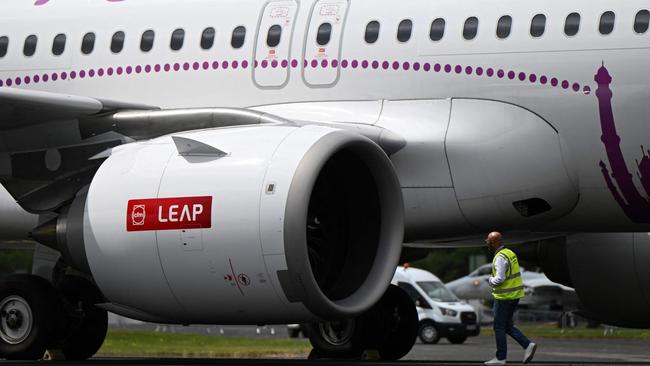Airport figures show travel still behind 2019 levels as report warns fleet constraints are worsening
High airfares, capacity constraints and subdued business travel have kept passenger numbers at Australia’s major airports below pre-Covid-19 levels everywhere but in the west.
Perth Airport is the only one of Australia’s four biggest gateways to have surpassed pre-Covid-19 passenger numbers, as the slow return of business travel, an aircraft shortage and high airfares constrain east coast airports.
The data came as a new report by Bain & Co warned that airlines would face fleet constraints through to the end of the decade because of increasing delays on the engine maintenance front.
In the year to June 30, 16 million people passed through Perth Airport for the first time, smashing the gateway’s previous passenger record of 14.9 million set in 2014.
Sydney Airport remained Australia’s biggest gateway, with 40.53 million passengers trekking through the three terminals, compared to 44.4 million in the same period five years ago.
Just over 35 million flew in and out of Melbourne Airport, or 94 per cent of pre-pandemic numbers, and Brisbane welcomed 22.6 million people through its gates, or 95 per cent of 2019 levels.
Perth Airport chief executive Jason Waters said the rebound from Covid-19 had been “nothing short of astounding” with more than 10 million passengers added since 2021.
“The remarkable thing is we expect this growth to continue as airlines show their confidence in the West Australian market,” he said.
“We are now getting on with the job of investing $5bn in new infrastructure to provide the additional capacity our airline partners need to grow their business.”
The biggest driver of growth at Perth Airport was in the fly-in, fly-out sector, with the number of regional passengers topping 6 million, the highest ever recorded.

Sydney Airport CEO Scott Charlton said growth in international travel through the gateway continued to outstrip domestic, which he attributed to “higher airfares, a lack of capacity and a downturn in discretionary business travel affecting demand”.
As a result, domestic passenger numbers were 10 per cent behind 2019 levels at 24.75 million, and international 6 per cent short of pre-Covid numbers at 15.78 million.
“In the June quarter, we saw strong international passenger volumes with seat capacity growing across the markets of Japan, Korea, Thailand and Vietnam versus the same period last year,” Mr Charlton said.
“This was underpinned by increased frequencies including Thai Airways adding a second daily service to Bangkok, Jetstar putting on a new, three-weekly service to Osaka and VietJet Air adding a twice-weekly service to Hanoi.”
Brisbane Airport was also benefiting from a big boost in international services, with ten new routes coming online in the 2024 financial year to destinations in Japan, China, the Pacific Islands and Korea.
General manager of aviation Ryan Both said they were eagerly awaiting the launch of more US routes by December, with American Airlines to fly Brisbane-Dallas and Delta heading to Los Angeles.
“By the end of the year there will be five major carriers serving the North American market, providing a historic level of options and competition across the Pacific,” said Mr Both.
The airports’ data came as Bain & Co warned that airlines would face fleet constraints through to the end of the decade, because of growing backlogs on the engine maintenance front.
Engine shop turnaround times were now at historic highs, up 35 per cent for legacy engines, and 150 per cent for new generation engines.
“Unless maintenance and repair organisations act quickly to close this capacity gap, airlines will face higher costs to operate constrained fleets,” said Bain’s aerospace and defence co-leader Jim Harris.
“The financial costs on top of growing costs to decarbonise air travel is likely to slow passenger travel growth.”
Mr Harris said a combination of factors led to the “supply crunch”, including significant pent-up demand due to the deferral of engine shop visits during the pandemic.
That was exacerbated by new generation CFM International LEAP engines and Pratt & Whitney GTF engines requiring repairs in much greater numbers than anticipated.
“In addition, there is insufficient delivery of new generation aircraft due to supply chain constraints and quality setbacks,” he said.
“Deferred deliveries mean airlines continue to rely on ageing fleets, which also require servicing involving greater complexity and longer turnaround times.”






To join the conversation, please log in. Don't have an account? Register
Join the conversation, you are commenting as Logout